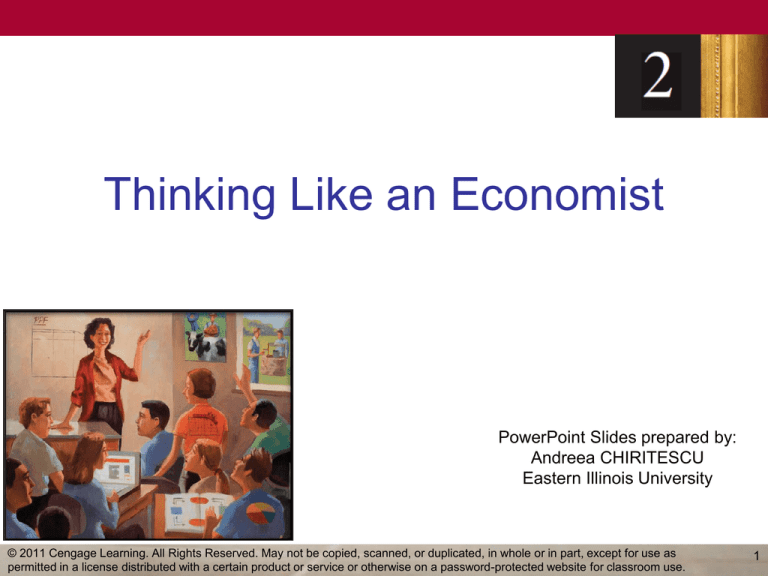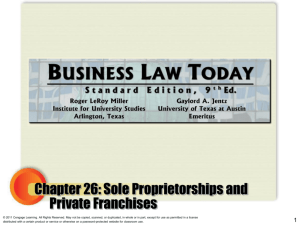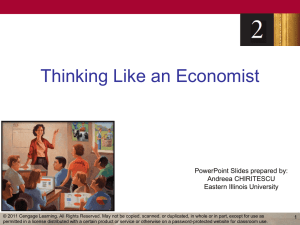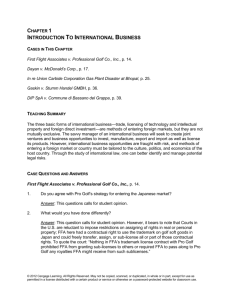
Thinking Like an Economist
PowerPoint Slides prepared by:
Andreea CHIRITESCU
Eastern Illinois University
© 2011 Cengage Learning. All Rights Reserved. May not be copied, scanned, or duplicated, in whole or in part, except for use as
permitted in a license distributed with a certain product or service or otherwise on a password-protected website for classroom use.
1
The Economist as a Scientist
• Economics
– Social science
• Economists
– Scientists
• Devise theories
• Collect data
• Analyze these data
– Verify or refute their theories
© 2011 Cengage Learning. All Rights Reserved. May not be copied, scanned, or duplicated, in whole or in part, except for use as
permitted in a license distributed with a certain product or service or otherwise on a password-protected website for classroom use.
2
The Economist as a Scientist
The role of assumptions
• Assumptions
– Can simplify the complex world
• Make it easier to understand
– Focus our thinking - essence of the
problem
• Different assumptions
– To answer different questions
– Short-run or long-run effects
© 2011 Cengage Learning. All Rights Reserved. May not be copied, scanned, or duplicated, in whole or in part, except for use as
permitted in a license distributed with a certain product or service or otherwise on a password-protected website for classroom use.
3
The Economist as a Scientist
• Economic models
– Diagrams & equations
– Omit many details
– Allow us to see what’s truly important
– Built with assumptions
– Simplify reality to improve our
understanding of it
© 2011 Cengage Learning. All Rights Reserved. May not be copied, scanned, or duplicated, in whole or in part, except for use as
permitted in a license distributed with a certain product or service or otherwise on a password-protected website for classroom use.
4
Which would you prefer if you want to find
your way to the Curlew parking lot?
Simple Map view
Real Arial View
•Or: Drive 2 miles, turn right on Ocean Dr.; drive 2,400 ft., turn right on Sand dollar Blvd.; drive
300 ft., turn right on Curlew Dr.; hit the brake
The Economist as a Scientist
• Circular-flow diagram
– Visual model of the economy
– Shows how dollars flow through markets
among households and firms
• Decision makers
– Firms & Households
• Markets
– For goods and services
– For factors of production
© 2011 Cengage Learning. All Rights Reserved. May not be copied, scanned, or duplicated, in whole or in part, except for use as
permitted in a license distributed with a certain product or service or otherwise on a password-protected website for classroom use.
6
FIGURE 1: The Circular-Flow Diagram
Revenue
G&S
sold
Markets for
Goods &
Services
Firms
Factors of
production
Wages, rent,
profit
Spending
G&S
bought
Households
Markets for
Factors of
Production
Labor, land,
capital
Income
•7
The Economist as a Scientist
• Firms
– Produce goods and services
– Use factors of production / inputs
• Households
– Own factors of production
– Consume goods and services
© 2011 Cengage Learning. All Rights Reserved. May not be copied, scanned, or duplicated, in whole or in part, except for use as
permitted in a license distributed with a certain product or service or otherwise on a password-protected website for classroom use.
8
The Economist as a Scientist
• Markets for goods and services
– Firms – sellers
– Households – buyers
• Markets for inputs
– Firms – buyers
– Households - sellers
© 2011 Cengage Learning. All Rights Reserved. May not be copied, scanned, or duplicated, in whole or in part, except for use as
permitted in a license distributed with a certain product or service or otherwise on a password-protected website for classroom use.
9
The Economist as a Scientist
• Production possibilities frontier
– A graph
– Combinations of output that the economy
can possibly produce
– Given the available
• Factors of production
• Production technology
© 2011 Cengage Learning. All Rights Reserved. May not be copied, scanned, or duplicated, in whole or in part, except for use as
permitted in a license distributed with a certain product or service or otherwise on a password-protected website for classroom use.
10
Figure 2
The production possibilities frontier
Quantity of
Computers
Produced
C
F
3,000
A
2,200
2,000
B
Production
Possibilities
Frontier
D
1,000
E
0
300
600 700
The production
possibilities frontier
shows the combinations
of output—in this case,
cars and computers—
that the economy can
possibly produce. The
economy can produce
any combination on or
inside the frontier. Points
outside the frontier are
not feasible given the
economy’s resources.
1,000 Quantity of
Cars Produced
© 2011 Cengage Learning. All Rights Reserved. May not be copied, scanned, or duplicated, in whole or in part, except for use as
permitted in a license distributed with a certain product or service or otherwise on a password-protected website for classroom use.
11
The Economist as a Scientist
• Efficient levels of production
– The economy is getting all it can
• From the scarce resources available
– Points on the production possibilities
frontier
– Trade-off:
• The only way to produce more of one good
• Is to produce less of the other good
© 2011 Cengage Learning. All Rights Reserved. May not be copied, scanned, or duplicated, in whole or in part, except for use as
permitted in a license distributed with a certain product or service or otherwise on a password-protected website for classroom use.
12
The Economist as a Scientist
• Inefficient levels of production
– Points inside production possibilities
frontier
• Opportunity cost of producing one good
– Give up producing the other good
– Slope of the production possibilities
frontier
© 2011 Cengage Learning. All Rights Reserved. May not be copied, scanned, or duplicated, in whole or in part, except for use as
permitted in a license distributed with a certain product or service or otherwise on a password-protected website for classroom use.
13
The Economist as a Scientist
• Technological advance
– Outward shift of the production possibilities
frontier
– Economic growth
– Produce more of both goods
© 2011 Cengage Learning. All Rights Reserved. May not be copied, scanned, or duplicated, in whole or in part, except for use as
permitted in a license distributed with a certain product or service or otherwise on a password-protected website for classroom use.
14
Figure 3
A shift in the production possibilities frontier
Quantity of
Computers
Produced
4,000
3,000
G
2,300
2,200
A
0
600 650
A technological advance
in the computer industry
enables the economy to
produce more computers
for any given number of
cars. As a result, the
production possibilities
frontier shifts outward. If
the economy moves
from point A to point G,
then the production of
both cars and computers
increases.
1,000 Quantity of
Cars Produced
© 2011 Cengage Learning. All Rights Reserved. May not be copied, scanned, or duplicated, in whole or in part, except for use as
permitted in a license distributed with a certain product or service or otherwise on a password-protected website for classroom use.
15
The Economist as a Scientist
• Microeconomics
– The study of how households and firms
make decisions
– And how they interact in markets
• Macroeconomics
– The study of economy-wide phenomena,
including inflation, unemployment, and
economic growth
© 2011 Cengage Learning. All Rights Reserved. May not be copied, scanned, or duplicated, in whole or in part, except for use as
permitted in a license distributed with a certain product or service or otherwise on a password-protected website for classroom use.
16
The Economist as a Policy Adviser
Positive vs. Normative analysis
• Positive statements
– Attempt to describe the world as it is
– Descriptive
– Confirm or refute by examining evidence
• Normative statements
– Attempt to prescribe how the world should
be
– Prescriptive
© 2011 Cengage Learning. All Rights Reserved. May not be copied, scanned, or duplicated, in whole or in part, except for use as
permitted in a license distributed with a certain product or service or otherwise on a password-protected website for classroom use.
17
The Economist as a Policy Adviser
• Economists in Washington
– Council of Economic Advisers
• Advise the president of the United states
• Annual Economic Report of the President
– Office of Management and Budget
– Department of the Treasury
– Department of Labor
– Department of Justice
– Congressional Budget Office
– The Federal Reserve
© 2011 Cengage Learning. All Rights Reserved. May not be copied, scanned, or duplicated, in whole or in part, except for use as
permitted in a license distributed with a certain product or service or otherwise on a password-protected website for classroom use.
18








